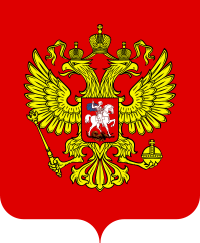Vladimir
| Vladimir (English) Владимир (Russian) |
|
|---|---|
 View of Vladimir |
|
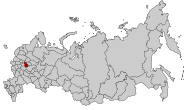 Location of Vladimir Oblast on the map of Russia |
|
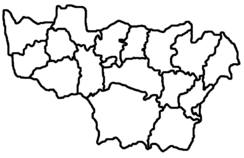 Location of Vladimir on the map of Vladimir Oblast
|
|
| Coordinates |
|
| Coat of Arms | Flag |
 |
 |
| City Day: May 1 | |
| Administrative status | |
| Federal subject In jurisdiction of Administrative center of |
Vladimir Oblast Vladimir Oblast Vladimir Oblast |
| Local self-government | |
| Charter | Charter of Vladimir |
| Municipal status | Urban okrug |
| Head | Alexander Rybakov |
| Legislative body | Council of People's Deputies |
| Area | |
| Area | 308 km² (118.9 sq mi) |
| Population (as of the 2002 Census) | |
| Population - Rank - Density |
315,954 inhabitants 58th 1,025.8/km² (2,656.8/sq mi) |
| Events | |
| Founded | 990 or 1108 |
| Other information | |
| Postal code | n/a |
| Dialing code | +7 4922 |
| Official website | |
| http://www.vladimir-city.ru/ | |
Vladimir (Russian: Влади́мир; Russian pronunciation: [vlɐˈdʲimʲɪr]) is a city in Russia, located on the Klyazma River, 200 kilometers (124 mi) to the east of Moscow along the M7 motorway. It is the administrative center of Vladimir Oblast. Population: 315,954 (2002 Census);[1] 349,702 (1989 Census).[2] Vladimir was one of the medieval capitals of Russia, and two of its cathedrals are a World Heritage Site. It is served by Vladimir Semyazino Airport, and during the Cold War Vladimir was host to Dobrynskoye air base.
Contents |
History
Foundation date controversy

The area occupied by the city of Vladimir has been inhabited by humans (at least intermittently) for approximately 25,000 years. Traditionally, the founding date of Vladimir has been acknowledged as 1108, as the first mention of Vladimir in the Primary Chronicle appears under that year. This view attributes the founding of the city, and its name, to Vladimir Monomakh, who inherited the region as part of the Rostov-Suzdal principality in the 1093. In 1958, the 850th anniversary of the city foundation was celebrated, with many monuments from the celebrations adorning the city squares.
In the 1990s, a new opinion developed that the city is older than this. Scholars reinterpreted certain passages in the Hypatian Codex, which mentions that the region was visited by Vladimir the Great, the "father" of Russian Orthodoxy, in 990, so as to move the city foundation date to that year. The defenders of the previously uncontested founding year of 1108 dispute the claims of those who support the new date, arguing that the new theory was fabricated in order to provide a reason to have a celebration in 1995.
The neighboring town of Suzdal, for instance, was mentioned in 1024, and yet its 12th century inhabitants alluded to Vladimir as a young town and treated its rulers with arrogance. In the words of a major chronicle, they said that the people of Vladimir were "their kholops and scions". In the seniority conflicts of the 12th and early 13th centuries, Vladimir was repeatedly described as a "young town" compared to Suzdal and Rostov. The Charter of Vladimir, the basic law of the city passed in 2005, explicitly mentions 990 as the date of the city's foundation [1].
Golden Age
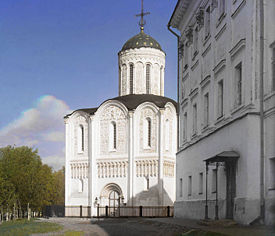
Regardless of which founding date is most accurate, the city's most historically significant events occurred after the turn of the 12th century. Serving its original purpose as a defensive outpost for the Rostov-Suzdal principality, Vladimir had little political or military influence throughout the reign of Vladimir Monomakh (1113–1125), or his son Yury Dolgoruky ("long arms") (1154–1157).
It was only under Dolgoruky's son, Andrei Bogolyubsky (1157-1175), that it became the center of the Vladimir-Suzdal principality. Thus began the city's Golden Age, which lasted until the Mongol invasion of Russia in 1237. During this time Vladimir enjoyed immense growth and prosperity, and Andrei oversaw the building of the Golden Gates and the Cathedral of the Assumption. In 1164, Andrei even attempted to establish a new metropolitanate in Vladimir, separate from that of Kiev, but was rebuffed by the Patriarch of Constantinople.[3]
Scores of Russian, German, and Georgian masons worked on Vladimir's white stone cathedrals, towers, and palaces. Unlike any other northern buildings, their exterior was elaborately carved with the high relief stone sculptures. Only three of these edifices stand today: the Assumption Cathedral, the Cathedral of St. Demetrios, and the Golden Gate. During Andrei's reign, a royal palace in Bogolyubovo was built, as well as the world-famous Intercession Church on the Nerl, now considered one of the jewels of ancient Russian architecture. Andrei was assassinated at his palace at Bogolyubovo in 1175.
Decline

On February 8, 1238, Vladimir was besieged and taken by the Mongol-Tatar hordes under Batu Khan. A great fire destroyed 32 limestone buildings on the first day alone, while the grand prince and all his family perished in a church where they sought refuge from the fire. The bishop of Vladimir managed to escape.
After the Mongols, Vladimir never fully recovered, and even though the most important Rus prince (usually the Prince of Moscow, but sometimes of Tver or another principality) was styled the Grand Prince of Vladimir and was the tax--collector of the Golden Horde. From 1299 to 1325, the city was seat of the metropolitans of Kiev and All Rus, until Metropolitan Peter moved the see to Moscow. The Grand Prince of Vladimir were originally crowned in Vladimir's Assumption Cathedral, but when Moscow superseded Vladimir as the seat of the Grand Prince, the Assumption Cathedral in the Moscow Kremlin, loosely copied by the Italian architect Aristotele Fioravanti from Vladimir's original, became the site where the grand princes were crowned. Even after the rise of Moscow though, Muscovite grand princes built several new churches in Vladimir, notably the Annunciation church at Snovitsy (ca. 1501), three kilometers north-west of the city, and a charming church in the Knyaginin nunnery (ca. 1505), with murals dating to 1648.
Remains of the prince-saint Alexander Nevsky were kept in the ancient Nativity abbey of Vladimir until 1703, when Peter the Great had them transferred to the Monastery (now Lavra) of Aleksandr Nevskyin St. Petersburg. The Nativity church itself (1191–1196) collapsed several years later, when they tried to make more windows in its walls, in an effort to brighten the interior.
Sightseeing

Modern Vladimir is a part of the Golden ring of the ancient Russian cities and a significant tourist center. Its three chief monuments, White Monuments of Vladimir and Suzdal, inscribed by UNESCO on the World Heritage List, are the following:
- The magnificent five-domed Assumption Cathedral was designed as a sepulcher of grand princes and dedicated to the holy icon Theotokos of Vladimir, which had been brought to the city by Andrew the Pious. The cathedral was constructed in 1158–1160, expanded in 1185–1189, and painted by the great Andrei Rublev and Daniil Chyorny in 1408. In 1810, they added a lofty bell-tower in Neoclassical style.
- The warrior-shaped cathedral of St. Demetrius was built in 1194–1197 as a private chapel of Vsevolod the Big Nest in the courtyard of his palace and was consecrated to his holy patron, St. Demetrius. For all its formal unity, the cathedral represents a truly international project of Russian and Byzantine masters, Friedrich Barbarossa's masons, and carvers sent by Queen Tamar of Georgia.
- The Golden Gate, originally a tower over the city's main gate, was built in 1158–1164. The gate acquired its present form after having been grossly reconstructed in the late 18th century, to prevent the dilapidated structure from tumbling down.

Other remarkable monuments of pre-Mongol Russian architecture are scattered in the vicinity. For more information on them, see Suzdal, Yuriev-Polsky, Bogolyubovo, and Kideksha.
Sister cities
Vladimir is twinned with:
 Canterbury, England.
Canterbury, England. Erlangen, Germany (since 1983).
Erlangen, Germany (since 1983).
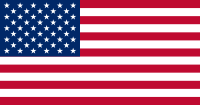 Bloomington-Normal, Illinois, United States.
Bloomington-Normal, Illinois, United States.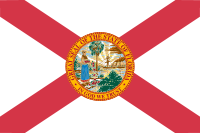
 Sarasota, Florida, United States.
Sarasota, Florida, United States.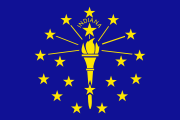
 Marion, Indiana, United States.
Marion, Indiana, United States.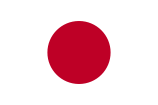 Nara, Japan. [4]
Nara, Japan. [4] Saintes, France.
Saintes, France.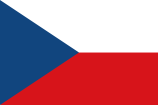 Ústí nad Labem, Czech Republic.
Ústí nad Labem, Czech Republic.
See also
- Theotokos of Vladimir
- Vladimir-Suzdal
References
- ↑ Федеральная служба государственной статистики (Federal State Statistics Service) (2004-05-21). "Численность населения России, субъектов Российской Федерации в составе федеральных округов, районов, городских поселений, сельских населённых пунктов – районных центров и сельских населённых пунктов с населением 3 тысячи и более человек (Population of Russia, its federal districts, federal subjects, districts, urban localities, rural localities—administrative centers, and rural localities with population of over 3,000)" (in Russian). Всероссийская перепись населения 2002 года (All-Russia Population Census of 2002). Federal State Statistics Service. Retrieved on 2008-07-25.
- ↑ "Всесоюзная перепись населения 1989 г. Численность наличного населения союзных и автономных республик, автономных областей и округов, краёв, областей, районов, городских поселений и сёл-райцентров. (All Union Population Census of 1989. Present population of union and autonomous republics, autonomous oblasts and okrugs, krais, oblasts, districts, urban settlements, and villages serving as district administrative centers.)" (in Russian). Всесоюзная перепись населения 1989 года (All-Union Population Census of 1989). Demoscope Weekly (website of the Institute of Demographics of the State University—Higher School of Economics (1989). Retrieved on 2007-12-13.
- ↑ Janet Martin, Medieval Russia: 980-1584 (Cambridge: Cambridge UP, 1995), 100.
- ↑ Sister cities of Vladimir
External links
- (English) Official website of Vladimir
- Information on the city of Vladimir (sites, attractions, tourist info, etc)
- http://www.allvladimir.ru/
- More abour Vladimir and other towns of the Golden Ring of Russia
|
||||||||||||||
|
|||||||
